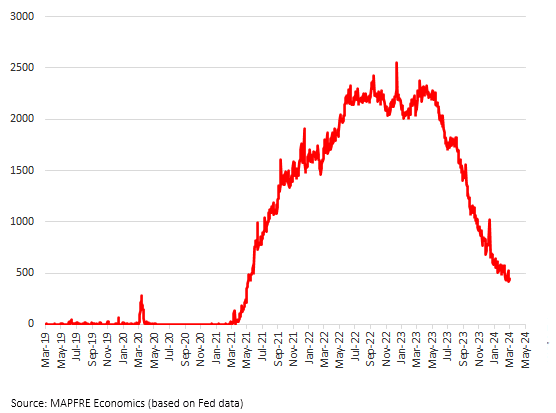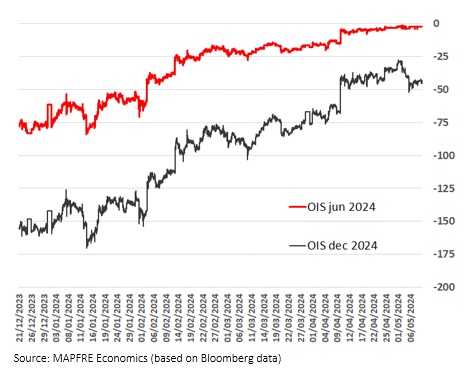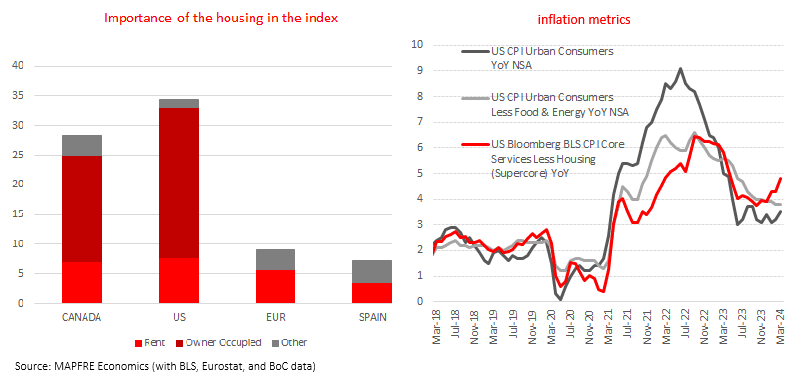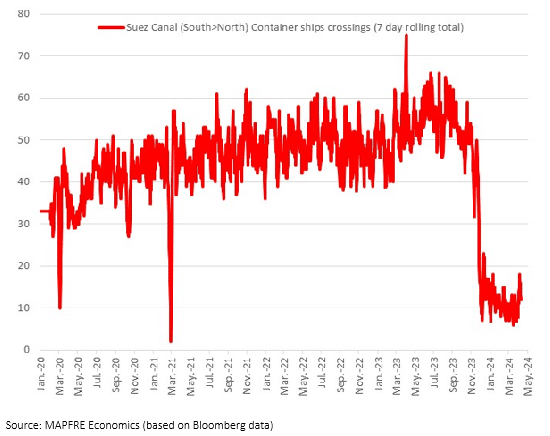Monetary Policy
Author: MAPFRE Economics
Federal Reserve
At its third meeting this year, the Federal Reserve once again decided to hold its benchmark interest rate at a range of 5.25%-5.50%, in line with market expectations that changes were unlikely. Regarding the outlook, while the dot plot has yet to be updated with the last 75 basis points (bps), Jerome Powell offered a slightly less optimistic narrative on the future path of interest rates, in light of some less encouraging progress on the macroeconomic side. This reversal is mainly explained by inflation, as progress toward the FOMC’s 2% inflation objective has been limited in recent months, suggesting that it could take longer than expected to generate the “greater confidence” necessary to begin cutting interest rates.
As for the balance sheet, in addition to the changes introduced earlier this year involving the Bank Term Funding Program (BTFP), burdened by rate arbitrage problems since its launch, the FOMC announced plans to slow the pace of decline of its security holdings from June onward by reducing the monthly redemption cap on Treasury securities from 60 billion to 25 billion dollars. It will maintain the monthly redemption cap on mortgage-backed securities (MBS) at 35 billion dollars and reinvest any principal payments in excess of this cap into Treasury securities. These announcements were also anticipated, as they were on the discussion table at the previous meeting and backed by the ongoing reductions in the use of the ON RRP facility (see Chart 1)1.
Chart 1. One-day inverse repos (ON-PRR)
(Billions USD)

This new pause, in line with the trend at recent meetings, came with a reminder that interest rate cuts would be a gradual path and always dependent on a series of macroeconomic data that, despite not justifying cuts right now, continues to suggest a more accommodative policy for the second half of the year. The confirmation of this roadmap led rate operators to discount from swaps the first 25 basis points of cuts between September and November, and an additional 25 bps in December; a volatile number, as illustrated by both the changes in expectations since the start of the year and the publication of the most recent data (see Chart 2). However, to a certain extent, it stays in the lane suggested by the Fed, allowing it to manage expectations as necessary.
Chart 2. Expected interest rates in June and December

The macroeconomic panorama remains favorable, as indicated in our most recent forecast update (2024 Economic and Industry Outlook: Second-Quarter Forecast Update). The data published to date shows that the deceleration continues, and once again, despite happening slower than expected (with a downside surprise in Q1), it still suggests a healthy expansion in terms of both consumer spending and positive investment performance. The latest PMI and ISM surveys also indicate that the manufacturing sector is starting to bottom out, setting the stage for recovery, while services remain in expansion territory, figures both compatible with an annualized 2% increase in GDP (in line with the expected potential).
As for the labor market, the overall data has yet to offer a clear picture. The unemployment rate increased to 3.9%, while labor participation remained unchanged at 62.7%, with the addition of just 175,000 jobs in April. Meanwhile, the Employment Cost Index (ECI) increased to over 4% in both the private and public sectors, an acceleration suggesting that a wage-price spiral cannot yet be ruled out.
As for inflation readings, the latest data confirms that the process is stagnating. The general CPI increased 0.44% month-over-month, with a new hike in energy prices, basic goods (which are once again producing positive contributions), services (which remain high), and more rigid housing inflation, a variable with significant bearing on the index compared to its European counterpart. This performance has also been observed in high readings of the core index (3.8% YOY) and in the so-called Supercore index (goods and services minus housing), with 4.5% YOY in Europe (see Charts 3 and 4).
Charts 3 and 4. Importance of housing in the CPI and inflation metrics

The fiscal path doesn’t appear to be a component that will change as campaign season ramps up either. Nonetheless, in the medium term this is a factor that will begin to include a possible return of Donald Trump to the White House, with a universal tariff policy, or the continuation of Joe Biden’s presidency, with a proposal of an additional 7.3 trillion dollar expenditure, both structurally inflationary elements, in 2025. This would put the Federal Reserve back at square one, where it found itself two years ago. This means it would continue calibrating to determine a neutral interest rate that could be higher than in the past (at least compared to the last cycle).
All in all, the timeline seems less favorable than anticipated and may veer toward a scenario with fewer cuts (none in the riskiest scenario), given the great inclination toward dynamic activity and employment, inflation stalled above the target, a historically high public deficit, and the same forces of change in global geopolitics that are threatening global financial stability.
European Central Bank
At its March meeting, the European Central Bank (ECB) left the three official interest rates unchanged for the fourth consecutive time, leaving the marginal lending facility rate at 4.75%, the rate on main refinancing operations at 4.50% and the deposit facility rate at 4.00%. On the balance sheet side, it maintained the roadmap through which it aims to reduce its size at a measured and predictable pace (no longer reinvesting maturities under the Asset Purchase Program, APP), as well as continuing with the planned change to the Pandemic Emergency Purchase Program (PEPP), which will give way to an interruption of reinvestments at the end of 2024 as well as a reduction process (in the second half of 2024) worth 7.5 billion euros per month on average. Finally, no additional guidance was presented for Targeted Longer-term Refinancing Operations (TLTROs).
At the macroeconomic level, this backdrop, despite offering few changes compared to December, lays the foundations for a more balanced vision in terms of both growth (which could well speed up in the second half of 2024, or even sooner, as suggested by the Q1 data) and price stability, with a predicted return to the central bank’s target within the forecast horizon (2025).
As a result of this, and a string of previous positive data, the rate cut discussion is no longer considered premature and is now open, offering clearer clues about June as the starting point for a relaxation of financial conditions, but suggesting caution beyond that date, in an exercise of prudence, given its growing divergences from its U.S. counterpart.
In summary, the ECB will maintain a reflective stance, as evidenced by the differing opinions of council members, as it awaits conclusive signs of change both internally and externally. The former seem encouraging, with a rebound in activity and price pressures that have not yet interrupted the path of disinflation, while the latter, rooted primarily in geopolitics, serve as a continued reminder that such factors that should not be ignored. This is particularly true in the case of Europe, given its closer proximity to the Red Sea crisis and dependency on the terms of trade (see Chart 5).
Chart 5. Container traffic through the Suez Canal




